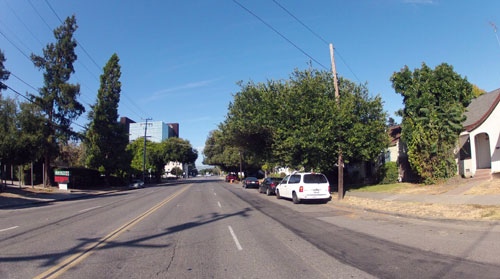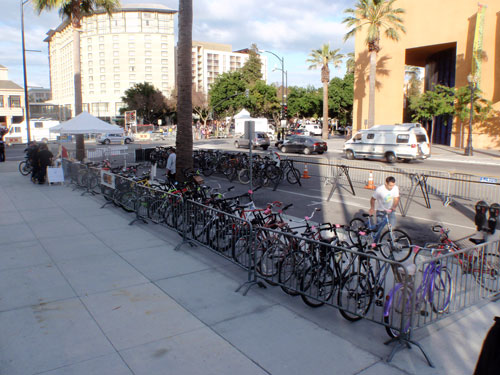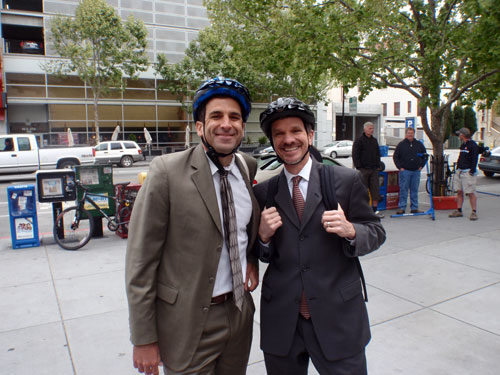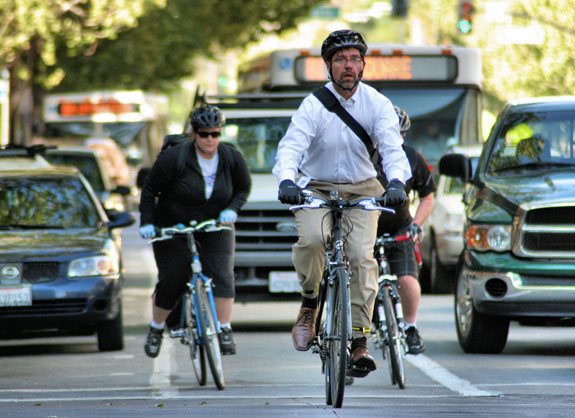
San Jose -- which wants its central district to become the urban center of Silicon Valley -- hopes to build the Bay Area's most bike-friendly downtown, where pedaling to work, school or the farmers market is "safe, convenient and commonplace" for people of all ages. The vision includes Long Beach-inspired bicycle-friendly business districts, where merchants would wholeheartedly embrace bike-riding shoppers and diners.
"Our ambition is to retrofit a city that has been built for cars into one that is built for people," said Council Member Sam Liccardo, who represents downtown and commutes by bike to San Jose City Hall three days a week. "The vibrancy that we hope and expect it will bring to our streetscape will start to change perceptions of San Jose throughout the region."
The city is also planning beyond downtown and wants to create a strong network of convenient crosstown bikeways linking the auto-oriented suburban ring to the transit-rich urban core.
"It's sunny 300 days a year and we don't have San Francisco hills," said Colin Heyne, deputy director of the Silicon Valley Bike Coalition. "Nature has given us this opportunity to become a great place to walk and bike."
Though only 1.2 percent of San Jose residents commute by bike, according to the city's tally, anecdotally the trend seems to be pointing toward higher rates. The popular San Jose Bike Party has helped to boost ridership, drawing many first time riders inspired by the impressive monthly display of bike culture. The city has set a 5 percent bike mode share goal by 2020, and 15 percent by 2040.
A number of bike commuters come from across the Bay Area -- from San Mateo, San Francisco, and Alameda counties -- using the Bay Trail, or they make multi-modal trips to work in downtown San Jose via Caltrain and VTA.
Metropolitan Transportation Commission officials say the numbers are hard to officially track, but they know this is a pattern because of the number of people taking their bikes aboard Caltrain. The need for commuters to make short trips by bicycle from key transit stops in San Jose is one reason why the city is taking part in the Bay Area's Bike Share pilot later this year, and better bike infrastructure is expected to draw more riders.
Jessica Zenk of the Silicon Valley Leadership Group said a growing number of companies, including start-ups, offer incentives to bike and take transit. "It's emblematic of the fact that these workers are really choosing quality of life when they choose companies and our member companies know that," she said.
John Brazil, the bicycle and pedestrian coordinator for the San Jose Department of Transportation, said the city is already one step ahead on its downtown goal because "the percentage of streets in our downtown core that have bike facilities is relatively high compared to other large cities in the region."
San Jose's downtown once had an extensive streetcar system that made it very walkable and bikeable in the early part of the 20th Century. As this Urbanist piece points out, the rise of the automobile in the 1950s and 60s brought rapid population growth to San Jose, and the city sprawled out, annexing land and building a profusion of single-family subdivisions. Streets were widened and some were turned into arterials to maximize auto throughput.
Today, the city wants to reduce its reliance on the automobile by achieving ambitious smart growth and sustainability goals outlined in its general plan update, known as Envision 2040. One major strategy calls for locating new housing and job growth along grand boulevards in 70 urban villages. Downtown -- which will be easier to transform because of its original streetcar grid of short blocks -- would build up and remain the cultural, job and entertainment center, and it would be a breeze to get there by bike, bus or light rail.
One simple and inexpensive way to begin achieving the Envision 2040 goals is to build out bike infrastructure. It will also help reduce the city's obesity rate. Local health figures from 2010 show that 56 percent of San Jose residents are overweight or obese, a number that has actually risen over the years. The Santa Clara County Public Health Department estimates the economic impact from the city's obesity epidemic could top $1 billion by 2018.
New Bike Facilities
So far this summer, SJDOT has installed eight miles of buffered bike lanes downtown, on 3rd, 4th, 10th, and 11th, with new standard lanes on Alamaden, and more are on the way. Five of the north-south streets got road diets. The buffered bike lanes are comfortably wide -- up to eight feet on many sections -- with the boundaries on each side providing good distance from autos. In the case of 4th Street, the city painted its first parking-protected bike lane. Existing bike lanes on San Fernando Way, an important east-west connection, will soon be transformed into the city's first green bike lanes, providing a friendlier bike corridor linking the Diridon Transit Center to San Jose State and downtown. Next year, the city will consider timing the signals on San Fernando for bicyclists.
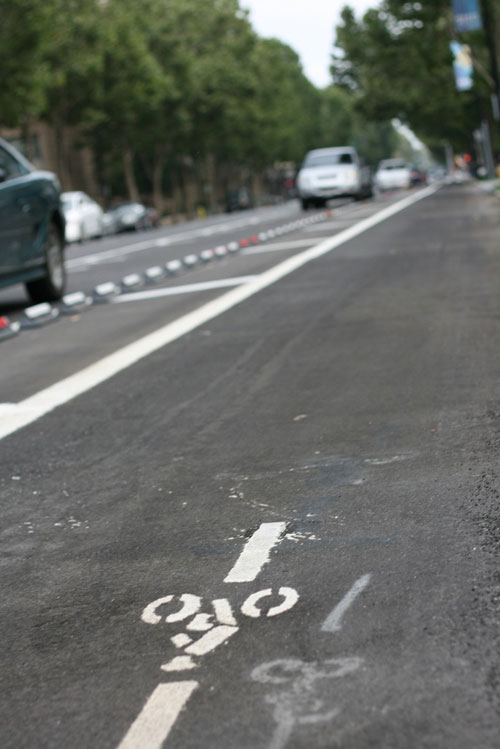
Liccardo was instrumental in getting the city to go beyond the standard bike lane. "I was pushing for buffered and segregated lanes along key corridors because I felt that San Jose had a long way to go and we need to make a bold statement if we're going to start to move the needle on getting folks off of four wheels, and onto two," he told Streetsblog.
The city is also upgrading its trails system. Six unpaved miles of the Guadalupe River Trail are currently being paved into a multi-use path that bike riders can use year round. All told, the network of off-street trails and on-street bike lanes is about 55 percent done -- meaning 269 miles have been built of the original 500-mile goal.
"We have a growing, strong trail network in the city that is away from traffic, trails on creeks," Brazil, the bike/ped coordinator, explained. "The challenge is it doesn't reach most destinations, so at some point we need to go on-street to get people from the pleasant trail to their destination, and we define the subset of primary bikeways to make them feel trail-like, to give them enhancements to separate the bicyclists from traffic."
Gone from most of the latest infrastructure are the standard bike lanes that put bike riders in the door zone, even though Brazil said dooring represents less than one percent of bike collisions in San Jose. The city's priority is to install enhanced facilities on major corridors, and standard bike lanes on streets that don't have high traffic volumes.
"Objectively, there isn't a large risk of dooring, but subjectively people still feel like they're concerned about that. So it's important for us to build bikeways that make people feel comfortable and safe and actually are comfortable," he said, adding that SJDOT does analyze blocks for door zone risk and adjusts its design based on the results.
The bike plan sets out to reduce bike collisions by 50 percent. Many of the current collisions are caused by drivers pulling out of driveways, or turning at intersections. "Part of it is designing facilities where people can see each other better and yield when appropriate," Brazil said.
In addition to the enhanced bike lanes, the city is also installing 500 bike racks a year, and plans to add five on-street bike corrals in the next few months. It will also take part in the Bay Area's bike-share pilot later this year, which will offer 200 bikes at 20 stations.
Hedding Street Compromise
One key bike corridor slated for improvements -- and scheduled to be approved at tonight's San Jose City Council meeting -- is Hedding, a wide, mostly residential four-lane street. It links bike riders to the Guadalupe River Trail, the First Street light-rail corridor, and Civic Center, and will eventually lead to the Berryessa BART station.
"Hedding is pretty ideal. A lot of cyclists use it because it goes underneath Highway 87, so you don't need to cross the freeway," said Heyne of the SVBC.
As with its other projects, SJDOT -- which has done considerable outreach -- is planning to give Hedding a road diet as the street is resurfaced. The plan is to remove a travel lane in each direction and install wide buffered bike lanes that will stretch for 17 blocks, requiring the removal of car parking on 15 of those blocks. SJDOT determined there was sufficient parking on side streets to absorb the displaced cars, and that much of the parking along this span of Hedding was usually below capacity.
But the idea of losing on-street parking has drawn some opposition from residents, a typical challenge that San Jose and other Bay Area cities face as they expand bike infrastructure.
"We are getting some pushback," said Liccardo, who met with residents last Thursday and will be asking the City Council to revise the plan for Hedding.
A memo co-signed by Liccardo and Council Members Rose Herrera and Xavier Campos lays out the sentiments of some residents with homes facing Hedding: "Some observe that multi-family units lack adequate parking on-site to accommodate multiple vehicles, and they express concern about having seniors and parents with small kids having to hoof it from side streets, particularly when carrying groceries or other items."
The proposed amendments include keeping parking on the north side of Hedding Street between 2nd and 8th streets, and on the south side between 4th and 7th. When the BART station is completed in 2017, the plan would go back to the City Council for a reevaluation and consideration of further improvements.
"This is certainly not because of any loss of enthusiasm on my part for buffered or segregated bike lanes," Liccardo explained. "It's more because of a recognition that this is a marathon and not a sprint and we need to have strong community support for expanding the network, and sometimes that requires that you need to give a little in order to continue to push forward."
It will take a deep cultural shift to change San Jose's overall attitudes about parking removal and bike infrastructure, but a growing number of residents support the new bike facilities. Heyne said that at a recent public meeting, many residents expressed opposition to the removal of parking on Hedding, but prefaced their comments with support for the bike lanes, which will make the street safer and more pleasant for all users and increase the neighborhood's property values.
Bicycle-Friendly Business Districts
Many merchants are beginning to realize that embracing bicycles equals dollars, and that bicyclists in general have more disposable income than drivers. To get businesses behind the concept of Bicycle-Friendly Business districts, the city is hosting a conference this Wednesday night at the San Jose Silicon Valley Chamber of Commerce that is also sponsored by SVBC and SPUR San Jose. SPUR's Leah Toeniskoetter will also lead a Sunday bike tour of the new infrastructure.
"Businesses near good bicycle infrastructure have been shown to have stronger growth than businesses in auto-centric developments!" a flyer for the Wednesday event states. "With a momentous strategy of building innovative, inviting bicycle facilities, San Jose has a chance to become home to new Bike-Friendly Business Districts (BFBDs), where both employees and merchants ride."
The BFBD conference will feature one of the nation's foremost experts on Bicycle-Friendly Business Districts, April Economides of Green Octopus Consulting. In an email, she offered a preview of her presentation:
My talk will illustrate the business case for bicycling – both nationally and also with a more local look at the business district scale. I gear my talks toward Chamber of Commerce and Business Improvement District leaders and I hope several in and around San Jose will attend.
There is a very strong connection between bicycling and shopping locally. About 40% of the trips made in the U.S. are less than two miles, and a whopping 68% of these are driven. Converting some of these drives to bicycling trips alleviates road and parking congestion and brings more money to local businesses. For example, imagine a family that bikes two miles on a Saturday to go to a toy store and buy lunch, versus drives out of town to a mall – or a couple on a dinner date, or someone buying a birthday gift for a friend, etc.
Heyne of SVBC and the co-sponsors are hoping to draw a strong attendance. "We're trying to get business leaders in the city down there because change can be scary and we want them to know that change toward more bicycle-friendly streets is actually going to be healthy," he said.
Liccardo said that over time many restaurants and retailers in San Jose will begin to recognize that "when people start to view downtown as not a pass through but rather a place to linger and enjoy, their business picks up. So, I'm hopeful that we're going to count them among our stronger supporters in pushing this agenda."
